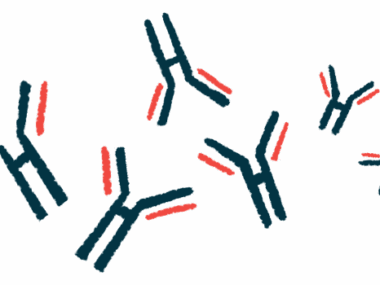EGPA disease symptoms don’t vary with ANCA status, study finds
Symptoms, manifestations similar in patients with and without ANCAs
Written by |

Symptoms and disease manifestations of eosinophilic granulomatosis with polyangiitis (EGPA), a rare type of ANCA-associated vasculitis (AAV), are generally similar between patients with and without ANCAs, the self-reactive antibodies that drive most AAV cases.
That’s according to a study analyzing data from a registry of people with vasculitis, or blood vessel inflammation, in Poland.
Data from the registry also allowed researchers to develop an algorithm that could discriminate between EGPA patients and those with granulomatosis with polyangiitis (GPA), another AAV type, and high levels of eosinophils, a type of immune cell, a hallmark of EGPA. Further studies are needed to validate the algorithm, the researchers said.
The study, “Clinical Characteristics of EGPA Patients in Comparison to GPA Subgroup with Increased Blood Eosinophilia from POLVAS Registry,” was published in the Journal of Immunology Research.
Most cases of AAV, a group of diseases marked by small blood vessel inflammation, are associated with the production of self-reactive antibodies called anti-neutrophil cytoplasmic autoantibodies.
Only 1 in 3 EGPA patients positive for ANCAs
EGPA, the rarest form of AAV, is characterized by very high levels of eosinophils and by symptoms that most commonly affect the lungs and gastrointestinal tract. Unlike other AAV types in which most patients are ANCA-positive, only about one in three people with EGPA is positive for ANCAs.
Researchers analyzed data from the Scientific Consortium of the Polish Vasculitis Registry (POLVAS) to assess whether EGPA manifestations vary based on ANCA status.
The analysis looked at data from 111 people diagnosed with EGPA from 1998 to 2020, 45 of whom (40.5%) were positive for ANCAs.
Statistical tests showed that ANCA-positive patients were significantly older at diagnosis (51.1 vs. 41.1) and experienced a significantly lower number of disease relapses (a median of one vs. two).
But symptoms, organ involvement, blood levels of eosinophil and inflammatory markers, and treatment patterns showed no significant differences based on ANCA status.
A subgroup analysis indicated that ANCA-negative patients had significantly higher rates of cardiovascular manifestations compared with those who were positive for a specific ANCA type that targets the myeloperoxidase (MPO) enzyme (47% vs. 27%).
“In our study, EGPA patients did not differ regarding ANCA status in main clinical manifestations,” the scientists wrote. However, they said, “comparison limited to the MPO-ANCA-positive vs. ANCA-negative subsets showed some differences,” such as the fact that “a higher prevalence of cardiovascular symptoms characterized the latter subset.”
Patients diagnosed prior to the 2012 update on criteria used to diagnose EGPA were significantly younger at diagnosis (41.3 vs. 49.2), and significantly more likely to have ear, nose, throat (91.4% vs. 68.3%) and cardiovascular (50% vs. 29.3%) manifestations.
Those diagnosed before the update also generally had signs of more severe disease, such as higher eosinophil levels and higher rates of disease relapses.
The researchers said this suggests that the new criteria “likely allowed the diagnosis of milder disease,” which may help improve long-term outcomes for patients.
The findings highlighted that “ANCA-positive and ANCA-negative EGPA patients did not differ in clinics, supporting their classification as a joint group,” the team wrote.
Still, they said, “cardiovascular symptoms were reported more often in ANCA-negative than MPO-ANCA-positive patients … [suggesting that] not the ANCA presence in general but MPO-ANCA status is critical for differentiating EGPA in terms of clinical and likely therapeutic strategy.”
Avoiding diagnostic confusion
Given that elevated levels of eosinophils have been reported in some people with GPA, a more common type of AAV that shares some clinical features with EGPA, “diagnostic confusion may lead to inappropriate therapy,” the researchers wrote.
They used POLVAS data to assess whether clinical features differed between the 111 EGPA patients and 42 GPA patients with relatively high eosinophil levels. The goal, they said, was to “look for potential similarities that may inform future diagnostic processes and treatment strategies.”
The results showed that EGPA patients had similar age at diagnosis and rates of skin and gastrointestinal manifestations as GPA patients with high eosinophils.
However, the EGPA group had significantly higher rates of respiratory, cardiovascular, and/or neurological involvement, while muscle, eye, and/or kidney involvement were significantly more common in the high-eosinophil GPA group.
EGPA patients also had significantly higher relapse rates and higher levels of eosinophils, but significantly lower levels of an inflammatory marker called C-reactive protein at diagnosis.
These differences prompted the researchers to create a simple algorithm, based on ANCA status and patterns of symptoms, to distinguish between the two groups of patients. The algorithm showed high accuracy, only misclassifying a handful of patients: two in the high-eosinophil GPA group (4.8%) and four in the EGPA group (3.6%).
“The proposed algorithm effectively differentiating EGPA and GPA [with high eosinophil count] cases is a novel and interesting approach,” the researchers wrote, adding, however, that “its validation requires further investigation.”







